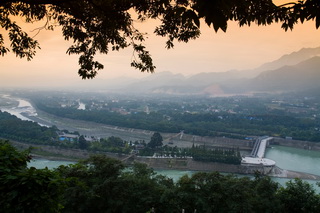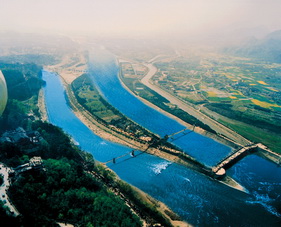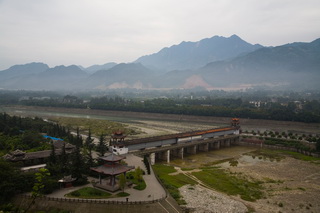 The Dujiangyan Irrigation Project in Southwest China's Sichuan Province represents ancient China's superb science and technology and is a milestone in the world's water harnessing and irrigation history. Dujiangyan, the world's oldest diversion project without a dam, still feeds a grid of irrigation canals watering 670,000 hectares (1,675,000 acres of farmland in Sichuan, turning the province into the country's famous land of abundance since ancient times.
The Dujiangyan Irrigation Project in Southwest China's Sichuan Province represents ancient China's superb science and technology and is a milestone in the world's water harnessing and irrigation history. Dujiangyan, the world's oldest diversion project without a dam, still feeds a grid of irrigation canals watering 670,000 hectares (1,675,000 acres of farmland in Sichuan, turning the province into the country's famous land of abundance since ancient times.Dujiangyan is the oldest and only surviving no-dam irrigation system in the world; and a wonder in the development of Chinese science. The project consists of three important parts, namely Yuzui, Feishayan and Baopingkou scientifically designed to automatically control the water flow of the rivers from the mountains to the plains throughout the year.
 Yuzui, like a big fish lying in the Minjiang River, is a watershed dividing the river into two parts Inner River and Outside River. FeishaYan is a spillway that diverts the sand and stones of the inner river into the outer river. Baoping Kou, like a neck of a bottle, is used to bring water into the inner river from Minjiang. At the same time, Baoping Kou controls the amount of the intake water due to its reasonable location. These three parts interact with each other perfectly to form an effective water conservancy project. During the low-water season, 60% of the Minjiang water is brought into the inner river for irrigation while 40% of the water is drawn into the outside river. The situation is reversed in the flood season ensuring the water supply for irrigation and protection from flooding on the Chengdu Plain.
Yuzui, like a big fish lying in the Minjiang River, is a watershed dividing the river into two parts Inner River and Outside River. FeishaYan is a spillway that diverts the sand and stones of the inner river into the outer river. Baoping Kou, like a neck of a bottle, is used to bring water into the inner river from Minjiang. At the same time, Baoping Kou controls the amount of the intake water due to its reasonable location. These three parts interact with each other perfectly to form an effective water conservancy project. During the low-water season, 60% of the Minjiang water is brought into the inner river for irrigation while 40% of the water is drawn into the outside river. The situation is reversed in the flood season ensuring the water supply for irrigation and protection from flooding on the Chengdu Plain.
There is a magnificent bridge called the Anlan Cable Bridge crossing the Minjiang River above Yuzui, which is the most scenic place in Dujiangyan. The construction of the bridge originally commenced before the Song Dynasty (960-1279). At that time, the body of the bridge was constructed with wooden blocks and the handrails were made of bamboo. Recently the wood and bamboo were replaced with steel and reinforced concrete to ensure the security of the visitors. Seen from afar, the bridge looks like a rainbow hanging over the river. From the bridge, you can clearly see the entire layout of the Dujiangyan system.
above Yuzui, which is the most scenic place in Dujiangyan. The construction of the bridge originally commenced before the Song Dynasty (960-1279). At that time, the body of the bridge was constructed with wooden blocks and the handrails were made of bamboo. Recently the wood and bamboo were replaced with steel and reinforced concrete to ensure the security of the visitors. Seen from afar, the bridge looks like a rainbow hanging over the river. From the bridge, you can clearly see the entire layout of the Dujiangyan system.

 China Tours
China Tours Tibet Tours
Tibet Tours China Theme Tours
China Theme Tours Off The Beaten Track
Off The Beaten Track Yangtze Cruises
Yangtze Cruises China Trip Planner
China Trip Planner Travel Agents
Travel Agents China Tours
China Tours Tibet Tours
Tibet Tours China Theme Tours
China Theme Tours Off The Beaten Track
Off The Beaten Track Yangtze Cruises
Yangtze Cruises China Trip Planner
China Trip Planner Travel Agents
Travel Agents


 0086-28-85711328
0086-28-85711328 0086-28-85546015
0086-28-85546015




 The Dujiangyan Irrigation Project in Southwest China's Sichuan Province represents ancient China's superb science and technology and is a milestone in the world's water harnessing and irrigation history. Dujiangyan, the world's oldest diversion project without a dam, still feeds a grid of irrigation canals watering 670,000 hectares (1,675,000 acres of farmland in Sichuan, turning the province into the country's famous land of abundance since ancient times.
The Dujiangyan Irrigation Project in Southwest China's Sichuan Province represents ancient China's superb science and technology and is a milestone in the world's water harnessing and irrigation history. Dujiangyan, the world's oldest diversion project without a dam, still feeds a grid of irrigation canals watering 670,000 hectares (1,675,000 acres of farmland in Sichuan, turning the province into the country's famous land of abundance since ancient times. Yuzui, like a big fish lying in the Minjiang River, is a watershed dividing the river into two parts Inner River and Outside River. FeishaYan is a spillway that diverts the sand and stones of the inner river into the outer river. Baoping Kou, like a neck of a bottle, is used to bring water into the inner river from Minjiang. At the same time, Baoping Kou controls the amount of the intake water due to its reasonable location. These three parts interact with each other perfectly to form an effective water conservancy project. During the low-water season, 60% of the Minjiang water is brought into the inner river for irrigation while 40% of the water is drawn into the outside river. The situation is reversed in the flood season ensuring the water supply for irrigation and protection from flooding on the Chengdu Plain.
Yuzui, like a big fish lying in the Minjiang River, is a watershed dividing the river into two parts Inner River and Outside River. FeishaYan is a spillway that diverts the sand and stones of the inner river into the outer river. Baoping Kou, like a neck of a bottle, is used to bring water into the inner river from Minjiang. At the same time, Baoping Kou controls the amount of the intake water due to its reasonable location. These three parts interact with each other perfectly to form an effective water conservancy project. During the low-water season, 60% of the Minjiang water is brought into the inner river for irrigation while 40% of the water is drawn into the outside river. The situation is reversed in the flood season ensuring the water supply for irrigation and protection from flooding on the Chengdu Plain. above Yuzui, which is the most scenic place in Dujiangyan. The construction of the bridge originally commenced before the Song Dynasty (960-1279). At that time, the body of the bridge was constructed with wooden blocks and the handrails were made of bamboo. Recently the wood and bamboo were replaced with steel and reinforced concrete to ensure the security of the visitors. Seen from afar, the bridge looks like a rainbow hanging over the river. From the bridge, you can clearly see the entire layout of the Dujiangyan system.
above Yuzui, which is the most scenic place in Dujiangyan. The construction of the bridge originally commenced before the Song Dynasty (960-1279). At that time, the body of the bridge was constructed with wooden blocks and the handrails were made of bamboo. Recently the wood and bamboo were replaced with steel and reinforced concrete to ensure the security of the visitors. Seen from afar, the bridge looks like a rainbow hanging over the river. From the bridge, you can clearly see the entire layout of the Dujiangyan system.